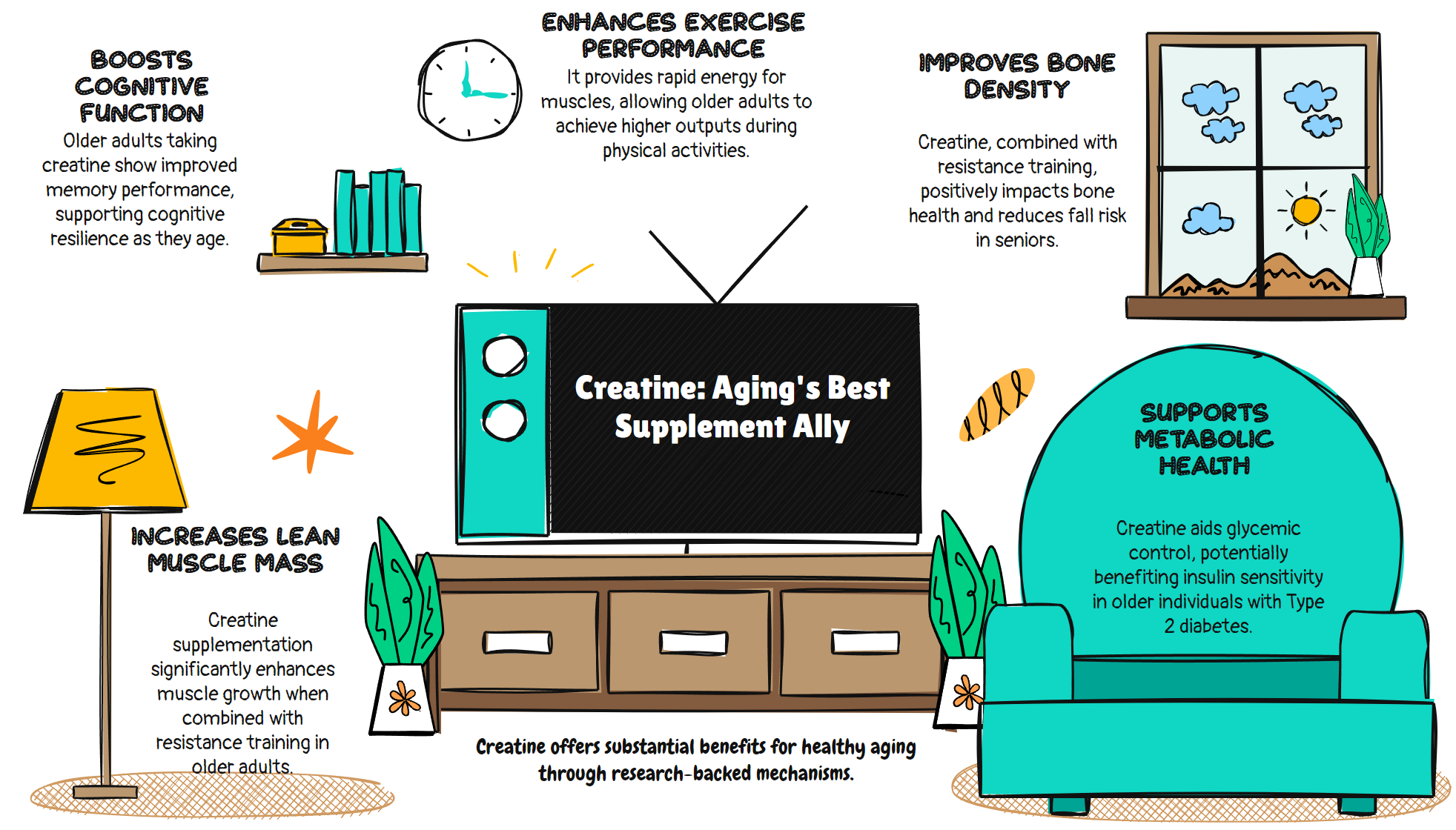
Why Creatine Becomes Essential After Age 50
Why Creatine Becomes Essential After Age 50
The supplement world is crowded with false promises. Yet one stands apart with decades of research behind it.
After fifty, your body begins changing the rules. Muscle mass declines predictably, cognitive processing slows, and energy reserves deplete faster. The cellular machinery that once rebounded quickly now takes its time.
These aren't just inconveniences. They're biological realities that affect everything from independence to quality of life.
Enter creatine – not as a miracle, but as something perhaps more valuable: a thoroughly researched compound with specific, measurable benefits for aging bodies.
The Science of Aging Muscle
Sarcopenia—the age-related loss of muscle mass and function—affects nearly everyone as they age. It's not just about aesthetics; it's about functionality, mobility, and independence.
Research shows that creatine supplementation increases lean tissue mass and muscle strength in aging adults. This isn't a marginal improvement. Studies demonstrate meaningful changes in muscle performance when creatine is combined with resistance training.
The mechanism is straightforward. Creatine serves as a rapid energy source for muscle cells during high-intensity activities. It helps regenerate ATP – the primary energy currency of cells – allowing for more work capacity during exercise.
For adults over 50, this translates to greater strength gains from the same amount of exercise.
One particularly interesting finding is that ingesting creatine immediately following resistance training appears to augment muscle accretion compared to resistance training alone. The timing matters.
Beyond Muscle: Cognitive Protection
The brain contains some of the body's highest concentrations of creatine. This isn't coincidental.
Neural tissue demands extraordinary energy. As we age, cognitive processing efficiency naturally declines. Creatine appears to help counteract this process.
Studies show that creatine supplementation enhances memory performance specifically in older adults aged 66-76. Younger adults didn't show the same benefits, suggesting that creatine addresses age-specific energy deficits in the brain.
This isn't just about remembering names or where you put your keys. It's about maintaining cognitive resilience as you age.
Research indicates creatine may provide neuroprotective effects. It supports brain energy metabolism when neural tissue is under stress, whether from aging, sleep deprivation, or cognitive demands.
Fall Prevention and Bone Density
Falls represent one of the most serious health risks for adults over 50. The consequences can be life-altering.
Several research groups have demonstrated that short-term creatine supplementation increases fatigue resistance and improves performance of activities of daily living in older adults.
Perhaps most intriguing: creatine supplementation combined with resistance training increases bone mineral density more than resistance training alone.
The connection? Creatine appears to affect the activation of cells involved in bone formation and resorption. This means it's not just helping the muscle—it's potentially strengthening the skeletal system that the muscle moves.
Metabolic Benefits for Aging Systems
Type 2 diabetes risk increases with age. Insulin sensitivity naturally declines as we get older.
Studies have shown that creatine supplementation combined with exercise positively affects glycemic control in people with type 2 diabetes. While not a replacement for medical intervention, it represents another potential benefit of this versatile compound.
The mechanism appears to involve improved glucose transport into muscle cells – a process that becomes less efficient with age.
Practical Implementation: Less Is More
The practical aspects of supplementation matter just as much as the benefits.
Contrary to bodybuilding mythology, you don't need massive "loading" doses of creatine. Research indicates that lower dosages (3-5g/day) are effective for increasing intramuscular creatine stores and improving performance.
Creatine monohydrate remains the most studied and cost-effective form. Fancy (and expensive) alternatives offer no proven advantages.
Timing may provide incremental benefits. For example, taking creatine post-exercise, possibly with a small carbohydrate, might enhance uptake. However, consistency matters more than perfect timing.
Hydration becomes essential when supplementing with creatine. It draws water into muscle cells, which is part of its effectiveness, but adequate fluid intake is critical.
Safety Profile for Older Adults
The safety question looms large for any supplement, especially for older adults who may have health concerns or take medications.
Research shows creatine supplementation does not appear to negatively affect markers of liver or kidney function in aging adults with healthy organ function.
A common confusion arises from blood tests. Creatine supplementation may elevate creatinine levels, which doctors often use as a kidney function marker. However, this elevation reflects increased creatine metabolism, not kidney damage.
For those with existing kidney disease, medical supervision becomes essential before supplementing.
The Bigger Picture
Creatine isn't magic. It won't reverse aging or replace a comprehensive approach to health.
What makes it remarkable is the convergence of benefits specifically relevant to adults over 50, from muscle preservation to cognitive support to metabolic health, all backed by substantial research.
The most compelling aspect may be its complementary relationship with exercise. Creatine enhances the benefits of physical activity, creating a virtuous cycle of improved capacity leading to more activity.
In a supplement landscape filled with exaggerated claims and minimal evidence, creatine stands apart. It offers specific, measurable benefits for the challenges that define aging.
The evidence suggests that for adults over 50, creatine isn't just another supplement. It's a foundational compound that addresses multiple facets of healthy aging through well-understood mechanisms.
The science is precise. The implementation is simple. The potential benefits are substantial.
